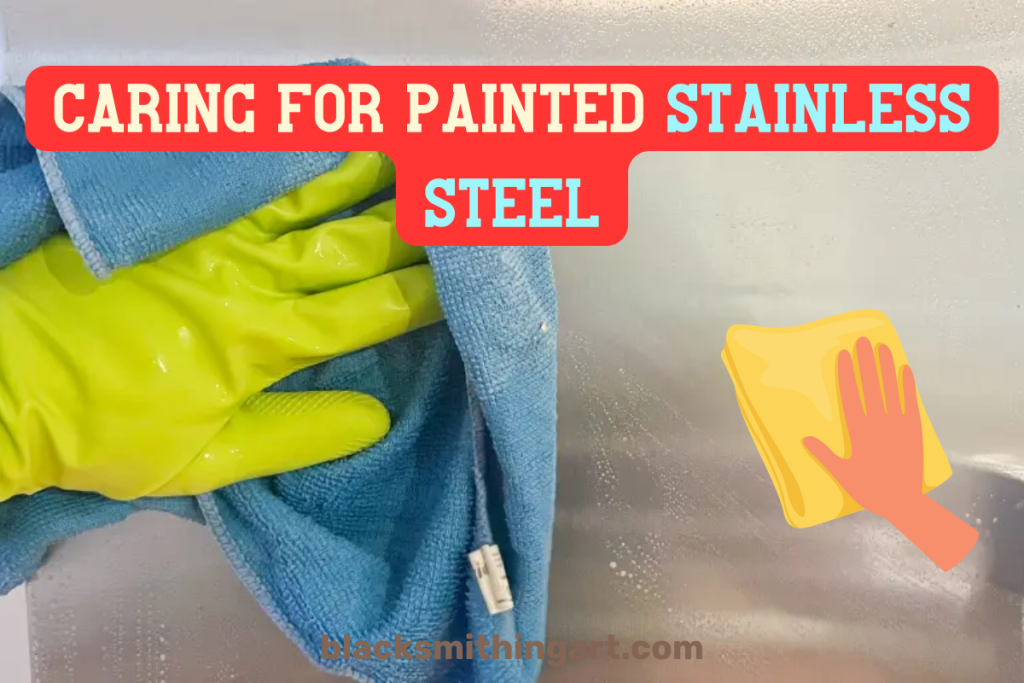
Have you ever looked at your stainless steel appliances and wondered, can you paint on stainless steel to give them a fresh coat of paint to match your kitchen’s color scheme? Or perhaps you need to protect a piece of stainless steel equipment from corrosion?
Well, you’re in luck! In this comprehensive guide, we’ll explore the ins and outs of painting stainless steel, covering everything from choosing the right paint to caring for your freshly painted surface. So grab your brushes and let’s dive in!
Contents
- 1 Can you paint on stainless steel?
- 2 Is It Possible to Paint Stainless Steel?
- 3 Choosing the Right Paint for Stainless Steel
- 4 Preparing Stainless Steel for Painting
- 5 Techniques for Painting Stainless Steel
- 6 Caring for Painted Stainless Steel
- 7 DIY vs. Hiring a Professional
- 8 Summary
- 9 Frequently Asked Questions
- 9.1 How do you get paint to stick to stainless steel?
- 9.2 Do you need special paint for stainless steel?
- 9.3 Can any type of paint be used on stainless steel?
- 9.4 Is it necessary to apply a primer before painting stainless steel?
- 9.5 How do I properly clean and prepare a stainless steel surface for painting?
Can you paint on stainless steel?
- Painting stainless steel is possible with the right preparation and paint, offering various benefits such as aesthetic appeal, corrosion protection, rust prevention and increased durability.
- The painting process requires careful consideration of the specific needs of a project or surface when selecting from oil-based, water-based or epoxy paints.
- Professional grade cleaning solutions are necessary to prepare surfaces for painting along with techniques such as brush strokes roller application or sprayer use. Regular care should also be taken once painted for preservation purposes.
Is It Possible to Paint Stainless Steel?

Yes, it is possible to paint stainless steel, given that you prepare the surface appropriately and use a suitable type of paint. Painting stainless steel offers several benefits, such as enhanced aesthetics and protection for welded areas, making it a popular choice for appliances and industrial settings alike.
However, keep in mind that certain paint systems may not be appropriate for stainless steel, and the painting process could pose certain challenges.
Benefits of Painting Stainless Steel

One of the main reasons to paint stainless steel is to improve its appearance. A fresh coat of paint can bring warmth and style to stainless steel surfaces, transforming them into eye-catching focal points in your home or workplace. Beyond aesthetics, a layer of paint on stainless steel can also offer corrosion protection, prevent rust, and enhance the durability of your surfaces.
Moreover, using a paint stick for applying paint evenly can help you achieve a smooth, professional-looking finish.
Limitations and Challenges

Despite the benefits of painting stainless steel, there are a few limitations and challenges to consider. One potential drawback is the reduction in corrosion resistance, which can be mitigated by applying a topcoat of marine varnish to provide additional protection, especially in humid or wet environments.
Furthermore, thorough surface preparation is necessary to guarantee proper paint adhesion and to preserve the stainless steel’s corrosion resistance.
Choosing the Right Paint for Stainless Steel

The selection of suitable paint is fundamental to a successful outcome when painting stainless steel. The type of paint you choose will depend on the specific needs of your project and the surface you’re working with.
We will discuss various types of paint that are compatible with stainless steel surfaces, such as oil-based, water-based, and epoxy paints.
Oil-Based Paints
Oil-based paints are known for their durability and resistance to chipping and staining compared to other types of paint. These paints are particularly suitable for metal finishes, including stainless steel, due to their corrosion resistance and pleasing finish. However, an oil based paint has some drawbacks, such as a strong odor and longer drying time.
Working in a well-ventilated area and taking necessary precautions is important when using oil-based paints.
Water-Based Paints
Water-based paints are generally easier to work with and have a faster drying time compared to oil-based paints. However, they may not be as durable or resilient as oil-based paints, making them less suitable for stainless steel surfaces.
Should you choose water-based paint for your project, remember to first apply a primer, as this ensures effective paint adhesion to the steel.
Epoxy Paints
Epoxy paints are considered the best choice for stainless steel surfaces due to their impressive durability, resistance to solvents, and ability to withstand extreme temperatures. These paints typically come in a two-part formula, which involves combining a resin paint with a hardener.
While the curing period for epoxy paint can range from three to seven days, the end result is a highly durable, long-lasting finish that’s well worth the wait.
Preparing Stainless Steel for Painting

You must appropriately prepare your stainless steel surface before initiating the painting process. This involves cleaning and degreasing the surface, roughening it, and applying a compatible primer.
We will guide you through each of these steps in detail, so your bare steel is prepared for a fresh coat of paint, ensuring the stainless steel properties are maintained.
Cleaning and Degreasing
Cleaning and degreasing the stainless steel surface is the primary step to ensure the paint adheres properly. This can be done using a water-based degreaser and a coarse plastic brush, or other cleaning solutions such as warm water, white vinegar, or window cleaner with a damp microfiber cloth.
For larger appliances or surfaces, you may need to use a specialized steel cleaner or degreaser from a home improvement store to effectively remove any dirt, oil, or grease.
Roughening the Surface
After ensuring your stainless steel surface is clean and devoid of debris, the next step is to roughen it for better paint adhesion. This can be achieved by using steel wool, fine-grit sandpaper, or an orbital sander if the surface is not already scratched.
You can also employ grinding, sweep blasting with non-metallic abrasives, or sanding as alternative methods to roughen the surface.
Remember to degrease the surface and wipe it down with acetone to ensure a successful acrylic paint application and a flawless final coat.
Applying Primer
Following the roughening of the surface, apply a primer designed specifically for stainless steel. Priming is essential for creating a smooth, even surface that conceals any imperfections while improving the adherence of the paint. Apply the primer evenly, following the manufacturer’s instructions, and allow it to dry before proceeding with the painting process.
Techniques for Painting Stainless Steel

Having prepared your stainless steel surface, you can now decide on the most suitable painting technique for your project. There are several methods available, including using a paintbrush, paint roller, or paint sprayer. Each technique offers its own advantages and challenges, which we’ll explore in more detail in the following subsections.
Using a Paintbrush
Using a paint brush offers several advantages:
- Precise application
- Better penetration into uneven surfaces
- Effective concealment of minor imperfections
- Greater control over paint application
- Ability to achieve desired finish
However, one drawback of using a paintbrush, as opposed to a wire brush, is that it may result in visible brush strokes on the finished surface, which can detract from the overall appearance.
Using a Paint Roller
Using a paint roller is another popular technique for painting stainless steel, providing a smooth, even finish that’s suitable for larger surfaces. To achieve the best results, select a roller with a long nap and use a W pattern when rolling.
However, this method may not be as suitable for small or intricate surfaces, and it’s essential to check for any drips or uneven sections after painting.
Using a Paint Sprayer
For the smoothest and most even application, consider using a paint sprayer or spray paint. This technique requires more preparation and cleanup, but the results are often worth the extra effort.
Before using a paint sprayer, verify the nozzle and air pressure settings, fill the paint reservoir, and adjust the spray pattern. Hold the sprayer 8-10 inches away from the surface and move it in a steady, even motion to ensure consistent coverage. After finishing, clean the paint sprayer thoroughly to prevent clogging and maintain its performance.
Caring for Painted Stainless Steel

After your stainless steel surface is freshly painted, maintaining its appearance and preventing damage requires proper care. This involves regular cleaning, inspecting and repairing chipped paint, and protecting the painted surface from potential harm.
In the following subsections, we’ll provide tips and advice for keeping your painted stainless steel looking its best.
Regular Cleaning
Preserving the look of painted stainless steel and averting potential damage necessitates regular cleaning. Use a damp microfiber cloth with warm water, vinegar, or window cleaner to clean the surface gently and effectively. Avoid using abrasive cleaners or scrub brushes, as they can damage the paint and compromise the integrity of your painted surface.
Inspecting and Repairing Chipped Paint
Your painted stainless steel surface may, over time, show signs of chipped or peeling paint. Regularly inspecting the surface and repairing any damage can help maintain a sleek appearance and prevent further deterioration.
To repair chipped paint, use a putty knife to remove the affected area, sand the surface, clean it thoroughly, and apply a primer and fresh coat of paint as needed.
Protecting Painted Surfaces
Protecting your painted stainless steel surface from potential harm is vital to ensure its longevity. Here are some tips to help you:
- Apply a coat of wax to the surface. Use a soft cloth to apply a thin layer of wax in a circular motion.
- Allow the wax to dry for at least 15 minutes.
- Buff off the wax with a clean cloth to give the surface a polished look.
By following these steps, you can help prevent staining and peeling of the paint on your stainless steel surface.
Additionally, sealing any cracks or crevices with a waterproof sealant can help prevent water damage and maintain the integrity of your painted surface.
DIY vs. Hiring a Professional

Considering the task of painting stainless steel, you might question whether to undertake the project yourself or engage a professional. DIY painting is a suitable option for small projects, offering cost-saving, customization, and flexibility.
However, for larger appliances or more complex tasks, hiring a professional is recommended to ensure the best results and maintain the corrosion resistance of your stainless steel surface.
Keep in mind that safety precautions, such as wearing gloves, eye protection, and a mask, are essential when undertaking any painting project.
Summary
In conclusion, painting stainless steel is a feasible and effective way to enhance the appearance and protect the surface of your appliances and equipment. With proper preparation, the right paint choice, and appropriate painting techniques, you can achieve a professional-looking finish that will last for years to come.
So, whether you decide to roll up your sleeves and tackle the project yourself or enlist the help of a professional, rest assured that with the knowledge gained from this comprehensive guide, you’ll be well-equipped to transform your stainless steel surfaces.
Frequently Asked Questions
How do you get paint to stick to stainless steel?
To get paint to stick to stainless steel, start by lightly sanding the surface. Then apply a rust-resistant primer rated for stainless steel followed by an oil-based paint. Finally, seal the paint job with a metal wax to ensure it stays put.
Do you need special paint for stainless steel?
For painting stainless steel, epoxy paint is the recommended coating system as it requires additional preparation and care to ensure proper adhesion. Sanding and cleaning the surface will also help the paint stick, and shot blasting is considered the best method for preparing stainless steel for paint.
Can any type of paint be used on stainless steel?
Using paint not specifically designed for stainless steel can have a negative effect, so it is important to use oil-based or epoxy paint when painting stainless steel.
Is it necessary to apply a primer before painting stainless steel?
Yes, it is necessary to apply a primer before painting stainless steel in order to ensure a strong bond between the paint and metal surface.
How do I properly clean and prepare a stainless steel surface for painting?
To properly prepare a stainless steel surface for painting, it is important to clean and degrease it, roughen it with steel wool or sandpaper, and apply a compatible primer.


